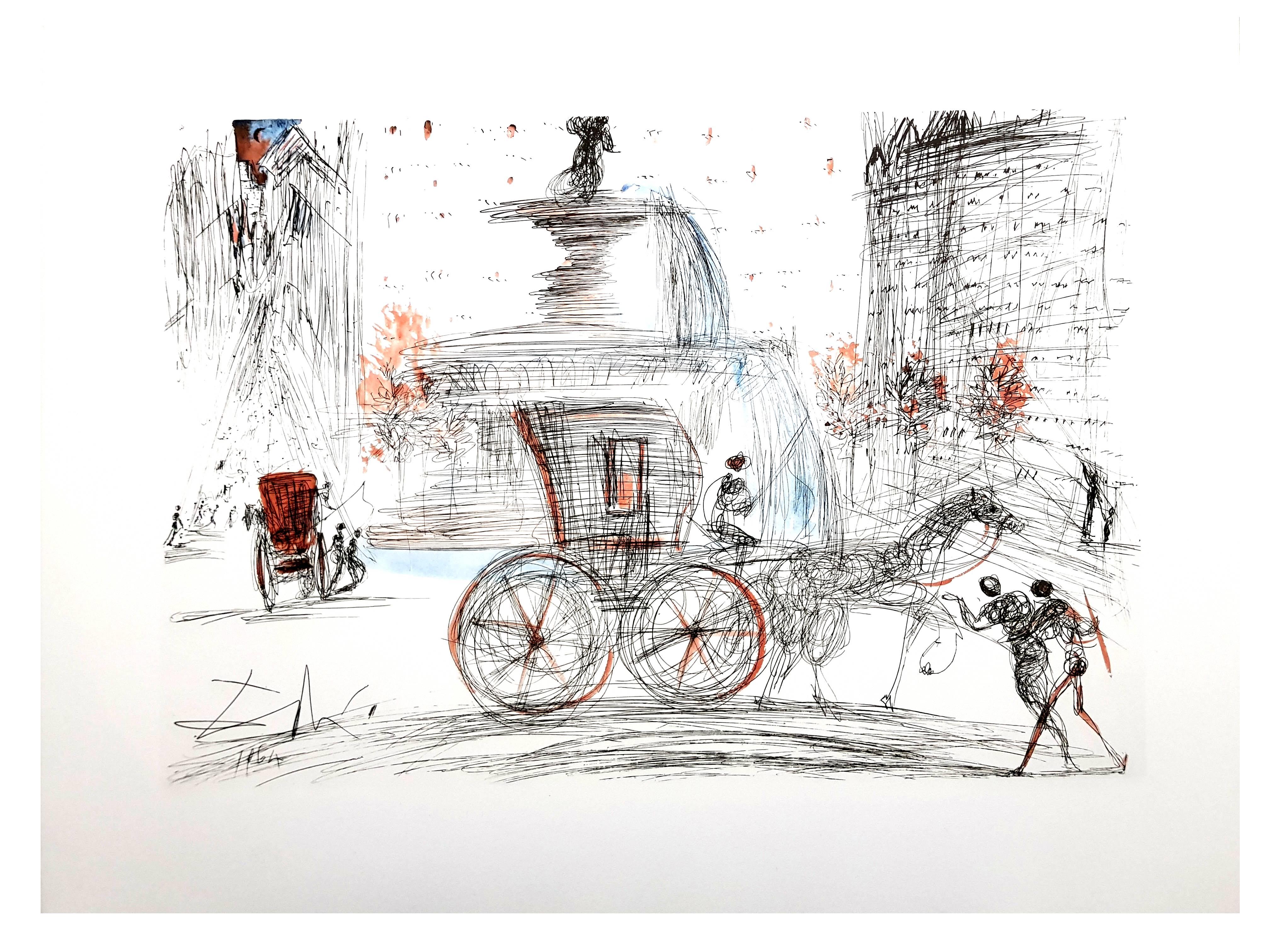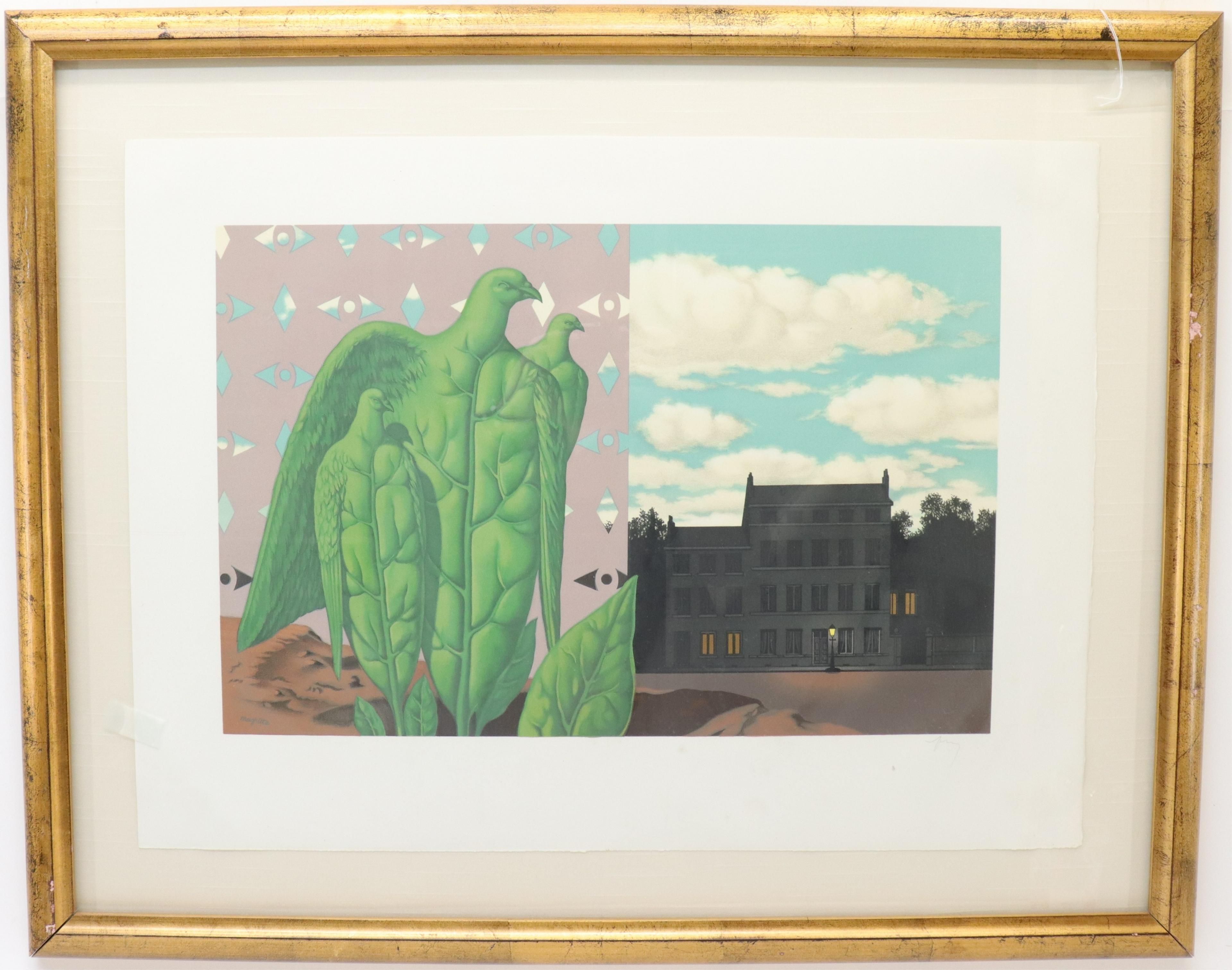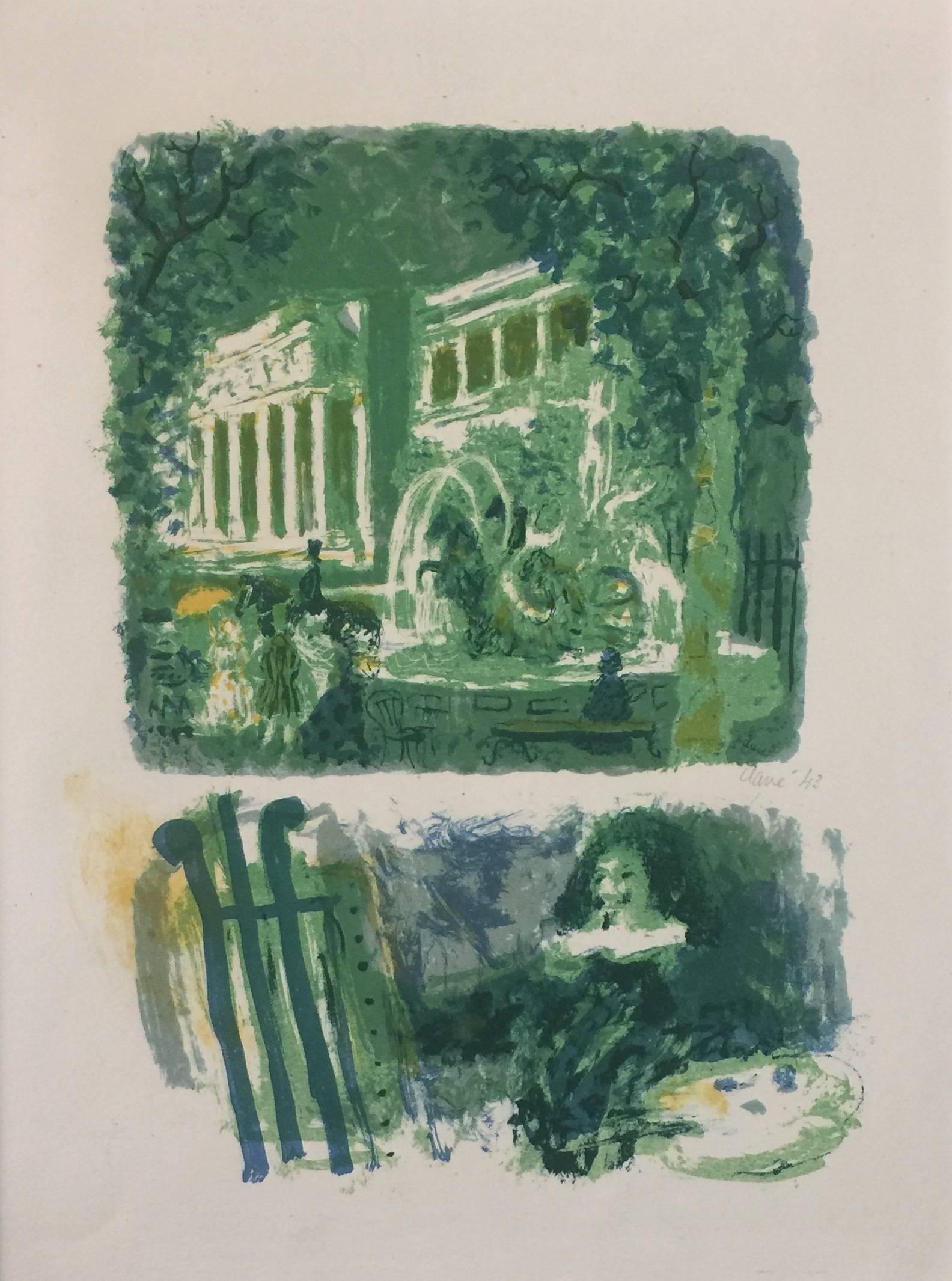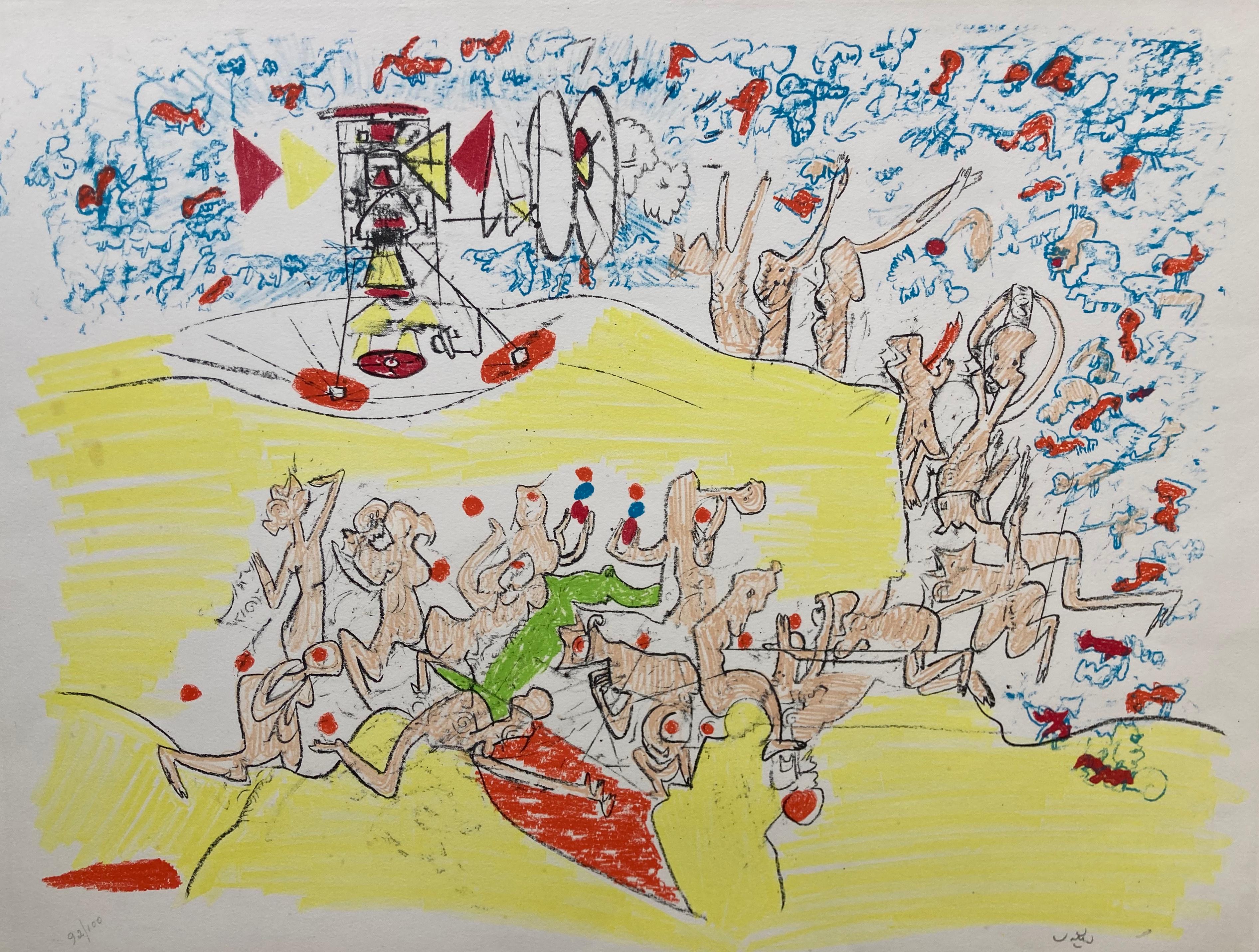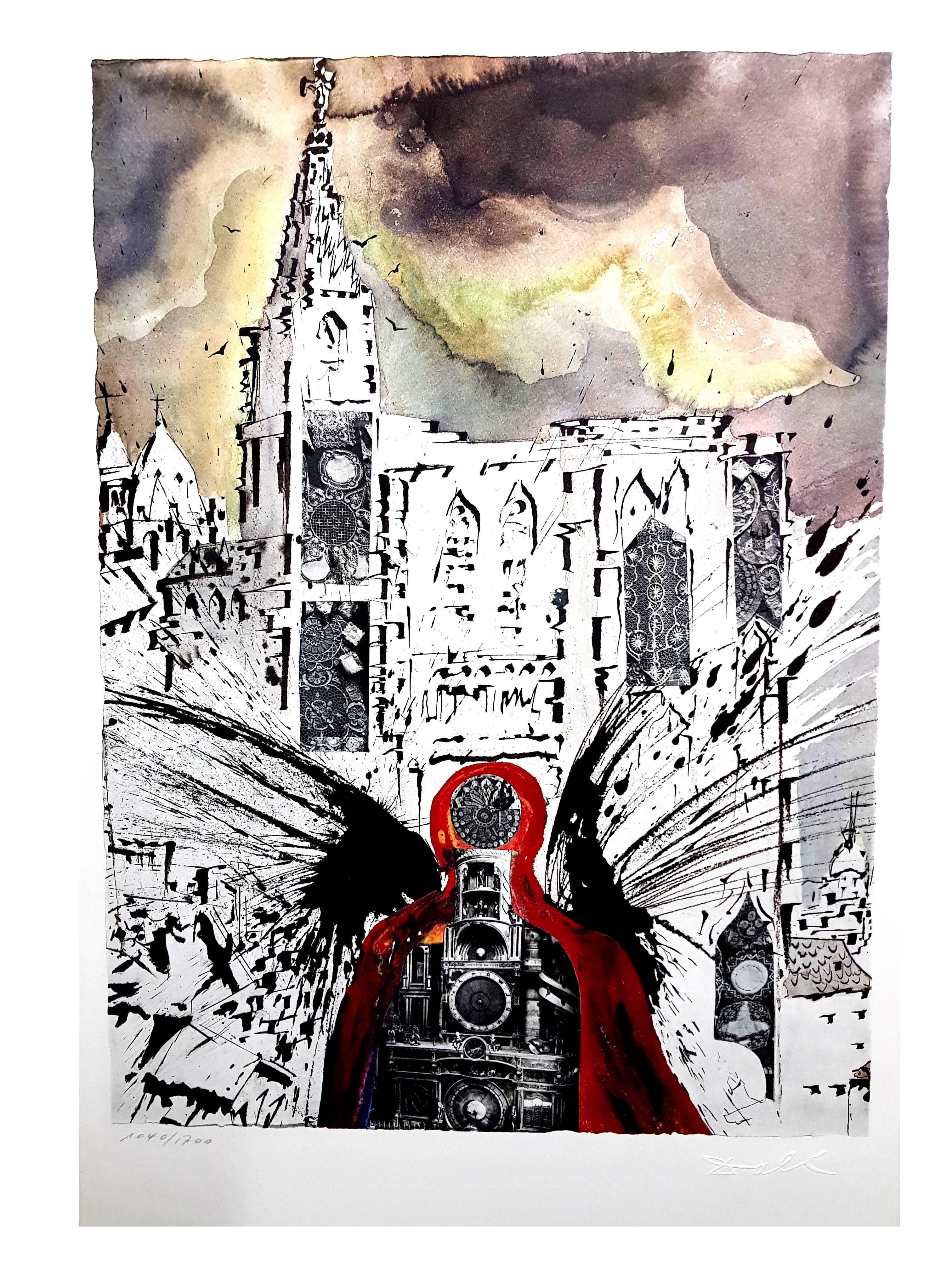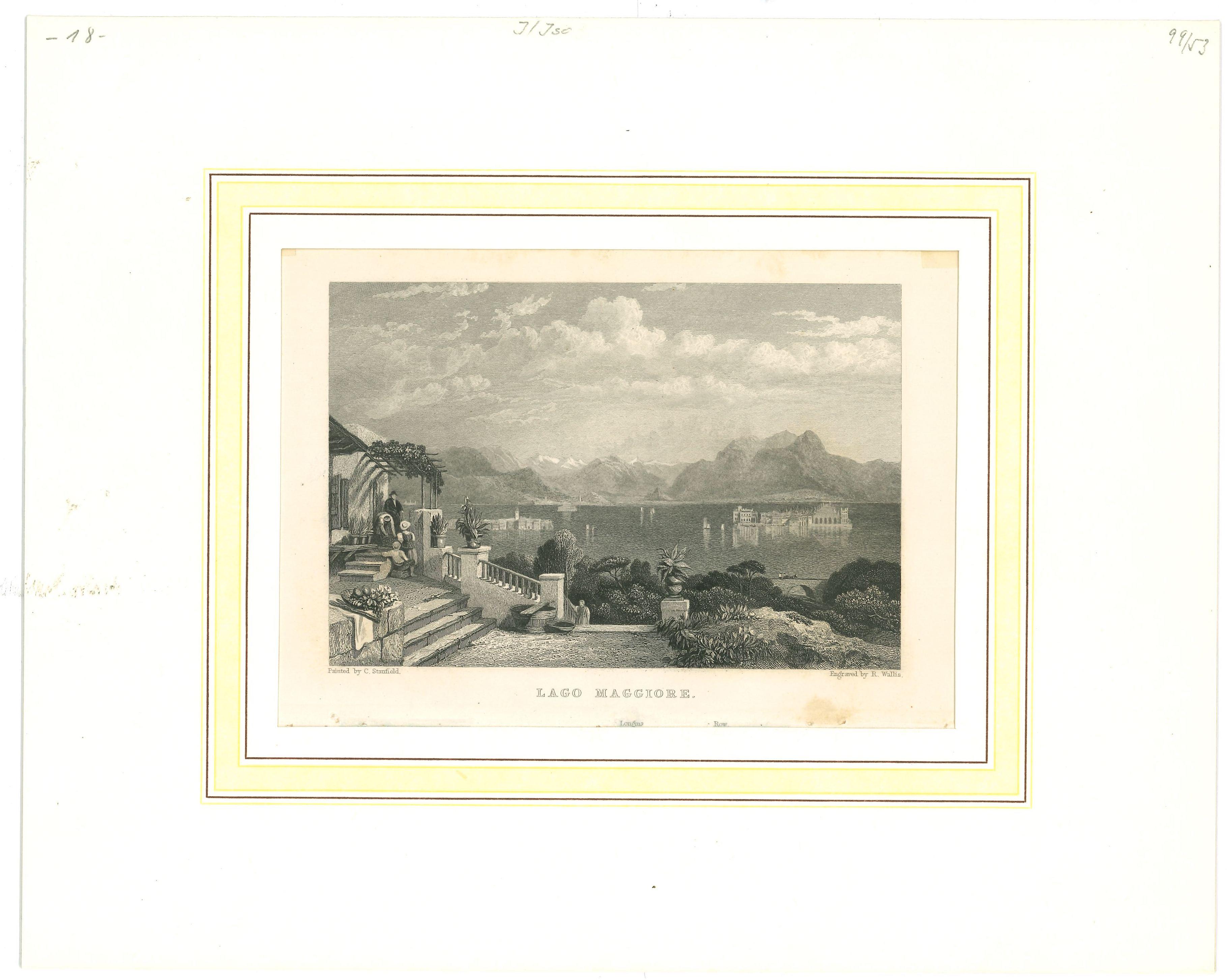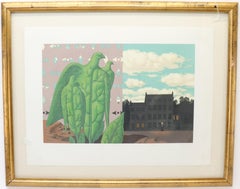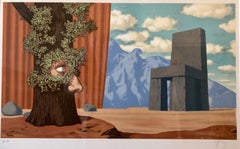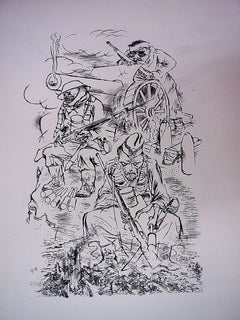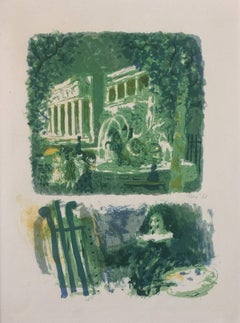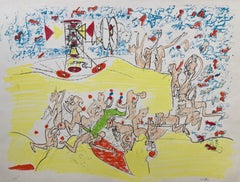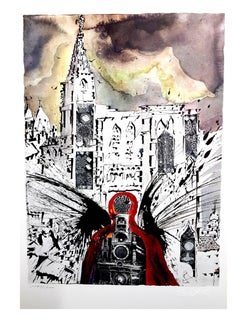Articles similaires à Large Colorful Jerusalem Israeli Judaica Surrealist Lithograph on Heavy Paper
Vous voulez plus d'images ou de vidéos ?
Demander au vendeur plus d'images ou de vidéos
1 sur 9
Baruch NachshonLarge Colorful Jerusalem Israeli Judaica Surrealist Lithograph on Heavy Paper
À propos de cet article
THis is a fabulous, Surrealist lithograph in bright fauvist colors by Hasidic mystic Boruch Nachshon
It depicts jerusalem with King David and a menorah in a Jerusalem Landscape.
Baruch Nachshon, was born in Mandatory Palestine in 1939, in the city of Haifa.
Nachshon began to paint in early childhood, and developed his relationship to art and to artists throughout his youth. During his military service Nachshon herded flocks for the IDF, an experience that imbued in him a love and appreciation for nature which figures prominently in his work until today. Upon completing his military service the young artist was torn between the temptation to travel to Paris, then the cultural center of the art world, and his deep love of the land of Israel, the spiritual center of the Jewish world. Opting to stay in Israel, Nachshon studied under Shlomo Nerani, Cezanne’s only pupil, with whom he had enjoyed a deep friendship extending back to his childhood. Nachshon, whom Nerani viewed as his spiritual heir, was the only one of his students allowed to see the master at work.
Nachshon’s lifelong involvement in the Lubavitch Chassidic movement began in his early adulthood, when he was drawn to the movement by its uniquely beautiful traditional melodies. In 1965 Nachshon was invited to an unprecedented three- hour private session with the Rebbe of Habad Lubavitch, Menachem Mendel Schneerson, in New York. The young artist used the opportunity to share his concerns and misgivings about the role of the Jewish artist and the many inherent conflicts which confronted him. The Rebbe blessed Nachshon with the advice that for many generations the art of painting had failed to find its ultimate rectification in holiness, but that with the help of God he might come to bring about that long anticipated rectification. The Rebbe then offered to fund Nachshon’s studies in New York on the condition that he would find a program of study acceptable to Jewish religious values. Despite the difficulty inherent in such a task, Nachshon gladly received the Rebbe’s offer and devoted himself fully to the celebration of the wisdom of the Creator through visual art.
In 1967 Nachshon and his wife Sara, along with six other families renewed the Jewish presence in Hebron for the first time since the city’s Jewish residents were massacred by Arabs in 1929. To underscore the significance of Jewish culture to the city, Nacshon opened a gallery of his art beside the Tomb of the Patriarchs. During this period Nachshon also used to visit the houses of Hebron’s Arab residents in order to paint the city from unique angles. On one of his regular visits to the Tomb of the Patriarchs, Nachshon met an elderly Breslov Hassid. The hassid urged him to recite Psalms every night for forty days, and assured him that if he did so he would merit profound revelation. Nachshon did so, and as soon as the forty days had passed he saw the heavens open, receiving visions that would charge his art forever. Since that first time, Nachshon has seen the heavens open many times and, indeed, the opening of the heavens is a recurring motif in his work. According to Nachshon, “the open sky means going beyond what is reality, seeing through.”
Nachshon’s art covers a wide range of thematic material through equally diverse stylistic approaches, all of which are uniquely his own. He paints in order to define and to emphasize the presence of the active Divine Will in creation, and in order to inspire himself and others. Nachshon paints what he sees through the eyes of an inspired painter, communicating those visions to the world. Each of his paintings can be studied in the manner of a sacred text, providing numerous and vivid insights into the workings of creation and the promises held for the future. Many of his paintings describe visions of the future, of the world after its final redemption, of a world where all is peace and joy and where the revelation of divine beneficence is clear to all. Until that time, Nachshon’s paintings offer a glimpse of what could be, of what ought to be and of what will be when the work of humanity has reached its successful completion. Nachshon is one of the Chabad artists championed by the Chai Gallery in Crown Heights, Brooklyn New York.
they have represented all of the major Lubavitch Hasidic artists such as Michael Gleizer, Hendel Lieberman, Zalman Kleinman, Michoel Muchnik as well as artists such as Samuel Rothbort, Harry Mccormick, Meer Akselrod and the Rebbe photos of Fridrich Vishinsky.
The Artist’s Prayer
I express my gratitude to you, artisan of creation, for you have endowed me with the spirit of your holy inspiration.
I beseech you- in your vast kindness- impart to me more and more of your holy inspiration so that I may rejoice in you, and give cause for rejoicing to your creations. Give me inspiration to reveal your presence, even in the darkest places, because everything is from you and before your presence all darkness is also light. You created your universe, and within it crafted all of your creatures so that they would come to acknowledge you.
And so- this, indeed is all I ask- kindness! For there is nothing else, no words in our mouths sufficient to thank you for having created us, having made us your children- the Children of Israel- and having brought us close to you in order to serve you. You have drawn forth our spirit and illuminated all- Well of Life.
-Baruch Nachshon, Hebron, 5749
- Créateur:Baruch Nachshon (1939, Israélien)
- Dimensions:Hauteur : 74,93 cm (29,5 po)Largeur : 55,88 cm (22 po)
- Support:
- Mouvement et style:
- Période:
- État:never framed.
- Adresse de la galerie:Surfside, FL
- Numéro de référence:1stDibs : LU38216391312
À propos du vendeur
4,9
Vendeur Platine
Vendeurs premium dont la note est supérieure à 4,7 et le délai de réponse de 24 heures maximum
Établi en 1995
Vendeur 1stDibs depuis 2014
1 766 ventes sur 1stDibs
Temps de réponse habituel : 1 heure
- ExpéditionRecherche du devis...Expédition depuis : Surfside, FL
- Politique des retours
Certaines parties de cette page ont été traduites automatiquement. 1stDibs ne garantit pas l'exactitude des traductions. L'anglais est la langue par défaut de ce site web.
Garantie d'authenticité
Bien qu'il soit peu probable que la situation se présente, dans le cas où vous rencontreriez un problème d'authenticité d'un article, contactez-nous dans un délai d'un an pour obtenir un remboursement intégral. DétailsGarantie de remboursement
Si votre article n'est pas conforme à la description, est endommagé pendant le transport ou ne vous est pas livré, contactez-nous sous 7 jours pour obtenir un remboursement intégral. DétailsAnnulation sous 24 heures
Vous disposez d'un délai de 24 heures pour annuler votre achat sans motif.Des vendeurs professionnels agréés
Nos vendeurs de renommée mondiale doivent respecter des normes strictes en matière de service et de qualité, afin de préserver l'intégrité de nos fiches produit.Garantie d'alignement des prix
Si vous constatez qu'un autre vendeur a mis en vente le même article à un prix inférieur sur un autre site, nous nous alignerons sur ce prix.Livraison en toute confiance à l'international
Notre réseau de transporteurs de premier ordre propose des options d'expédition spécialisées dans le monde entier, y compris des livraisons personnalisées.Plus d'articles de ce vendeur
Tout afficherLithographie surréaliste du maître belge Magritte signée par Mourlot
Par René Magritte
Artistics : René Magritte (d'après), Belge (1898 - 1967)
Titre : (extrait des Enfants Trouvés) Les Claires-Voies d'un Jeune Regard Embaument La Fête d'un Vieil Arbre
Année de la pein...
Catégorie
années 1960, Surréalisme, Estampes - Paysage
Matériaux
Lithographie
Lithographie surréaliste du maître belge Magritte signée par Mourlot
Par (after) René Magritte
Artistics : René Magritte (d'après), Belge (1898 - 1967)
Titre : (extrait des Enfants Trouvés) Les Claires-Voies d'un Jeune Regard Embaument La Fête d'un Vieil Arbre
Année de la pein...
Catégorie
années 1960, Surréalisme, Estampes - Paysage
Matériaux
Lithographie
Artiste japonais de la gravure sur bois Lithographie française Couleurs fauves École de Paris
Par Shungo Sekiguchi
Shungo Sekiguchi, (japonais, 1911-2002) :
Lithographie en couleur sur Rives papier
Signée au crayon en bas à droite, numérotée à la main
Il semble que ce soit le village de Montmarte à Paris.
Cet ouvrage a été publié par la Guild de la Gravure, Paris, France, et porte le cachet de la GG.
Il s'agissait d'un éditeur d'art français du milieu du siècle dernier qui a publié de nombreux maîtres tels que Raoul Dufy, Max Erns, Jean Hans Arp, Ruffino Tamayo, Balthus, Gino Severini et Leonard Tsuguharu Foujita.
Shungo Sekiguchi est né en 1911 au Japon. En 1932, Shungo Sekiguchi a contribué à la série de gravures "Cent vues du Grand Tokyo" (Dai Tokyo hyakkei). Gravures à partir d'aquarelles publiées par Kaneda Shoten (Nihon Hanga Ken-kyusho). En 1935, Sekiguchi s'installe à Paris, en France, pour étudier à la prestigieuse École des Beaux-Arts de France grâce à une bourse du gouvernement français. Il a étudié avec deux autres artistes japonais de l'Ecole de Paris, Takanori Ogisu et Tsuguji Foujita. Il a exposé au prestigieux "Salon d'Automne" à Paris. En 1940, lorsque Paris est occupé par les nazis allemands, Shungo Sekiguchi retourne au Japon, mais conserve ses liens avec la France. En 1952, il expose au célèbre Salon d'Automne et reçoit un prix. En 1959, il a reçu un prix au concours international d'art de Vicci. En 1964, il a reçu le diplôme d'honneur du Jobiji International Art Show. Son exposition rétrospective a été organisée dans de nombreux endroits au Japon.
En 2002, l'artiste est décédé au Japon. Il est populaire au Japon et plusieurs expositions rétrospectives ont été organisées dans ce pays. Il faisait partie des artistes de la gravure sur bois Shin Hanga et Sosaku Hanga, connus pour leurs gravures sur bois et leurs rouleaux. Le Shin-hanga est un mouvement artistique qui s'est développé au début du XXe siècle au Japon, durant les périodes Taisho et Showa, et qui a revitalisé l'art traditionnel ukiyo-e issu des périodes Edo et Meiji. Il a également travaillé comme illustrateur de livres et a réalisé la maquette de l'édition française de Le démon doré par Ozaki Kohyo. Il figure dans l'ouvrage classique de Helen Merritt et Nanako Yamada intitulé "Guide to Modern Japanese Woodblock...
Catégorie
années 1950, Post-impressionnisme, Estampes - Paysage
Matériaux
Lithographie
Lithographie de 1936 « Soldiers in battle », petite édition de la Première Guerre mondiale
Par George Grosz
D'après le frontispice, ils ont été produits par lithographie à la main. Selon le Musée d'art moderne (MOMA NY) website "Edition:300 announced ; only approx. 42 issued (including re...
Catégorie
années 1930, Estampes - Paysage
Matériaux
Lithographie
Lithographie figurative expressionniste allemande « La forêt » de Paul Kleinschmidt, 1920
Par Paul Kleinschmidt
Paul Kleinschmidt, (1883-1949)
"La forêt
Lithographie sur papier crème
1920
Cadre : 21" X 17"
Image : 10.75" X 8.5"
Scène de forêt expressionniste avec des pins
Provenance : porte de...
Catégorie
années 1920, Abstrait, Estampes - Figuratif
Matériaux
Lithographie, Papier
Silencio, Direccion Unica, gravure pop art espagnole « One Way Spanish Political », 1970
Par Juan Genoves
Juan Genovés Candel (espagnol, 1930-)
Peintre, illustrateur et graveur graphique. Il a peint "El abrazo" ("l'étreinte"), qui est devenue une affiche emblématique de la transition pol...
Catégorie
années 1970, Pop Art, Estampes - Figuratif
Matériaux
Lithographie
Suggestions
Salvador Dali (d'après) - New-York : Plaza (édition d'affiche) - Lithographie
Par (after) Salvador Dali
Lithographie d'après une aquarelle originale de Salvador Dali
Titre : New-York City : Plaza (édition d'affiches pré-texte/"avant la lettre")
Signature imprimée, datée de 1964
Dimensi...
Catégorie
années 1960, Surréalisme, Estampes - Figuratif
Matériaux
Lithographie
1 397 $US Prix de vente
20 % de remise
Composition - Lithographie originale en couleur d'Antonio Clavé - 1943
Par Antoni Clavé
Signé et daté à la main. Signé sur la plaque. Très bonnes conditions
Passepartout inclus : 49 x 34 cm
Dimensions de l'image : 25 x16 cm
Cette œuvre d'art est expédiée d'Italie. En v...
Catégorie
années 1940, Surréalisme, Estampes - Paysage
Matériaux
Lithographie
BROUILLARD, GOG ET MAGOG
Par Roberto Matta
ROBERTO MATTA (1911-2002)
BROUILLARD, GOG ET MAGOG 1971
Lithographie en couleur. Planche 1 de "Fog Gog, and Magog" 1971. Signé au crayon et numéroté. Cette œuvre est le numéro 92 de...
Catégorie
années 1970, Surréalisme, Estampes - Paysage
Matériaux
Lithographie
880 $US Prix de vente
20 % de remise
Salvador Dali (après) - Alsace - Lithographie
Par Salvador Dalí
Lithographie d'après Salvador Dali
Titre : S.N.S.C.F.
Tampon signé Dali
Dimensions : 46,5 x 34 cm : 46,5 x 34 cm
Édition : /1700
1969
Références : Catalogue raisonne Michler & Lopsi...
Catégorie
années 1960, Surréalisme, Estampes - Figuratif
Matériaux
Lithographie
Ancienne vue du Lago Maggiore - Lithographie sur papier - Milieu du 19e siècle
Ancient View of Lago Maggiore est une œuvre d'art moderne originale réalisée en Italie dans la première moitié du XIXe siècle.
Lithographie originale sur papier ivoire.
Inscrit d...
Catégorie
années 1850, Surréalisme, Estampes - Figuratif
Matériaux
Lithographie
A, Felip, Désolation
l'artiste, A. Felip est un mystère. Le titre, Désolation, dit tout. De plus, ce sujet d'après-guerre très captivant est si bien dessiné qu'il doit être l'œuvre d'un artiste expérimen...
Catégorie
années 1950, Surréalisme, Estampes - Paysage
Matériaux
Lithographie
